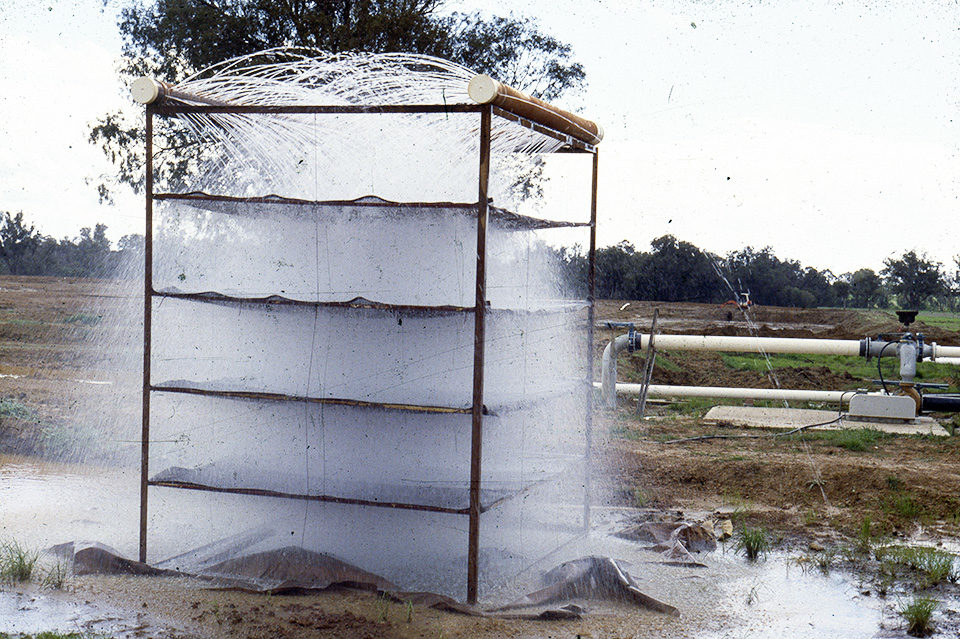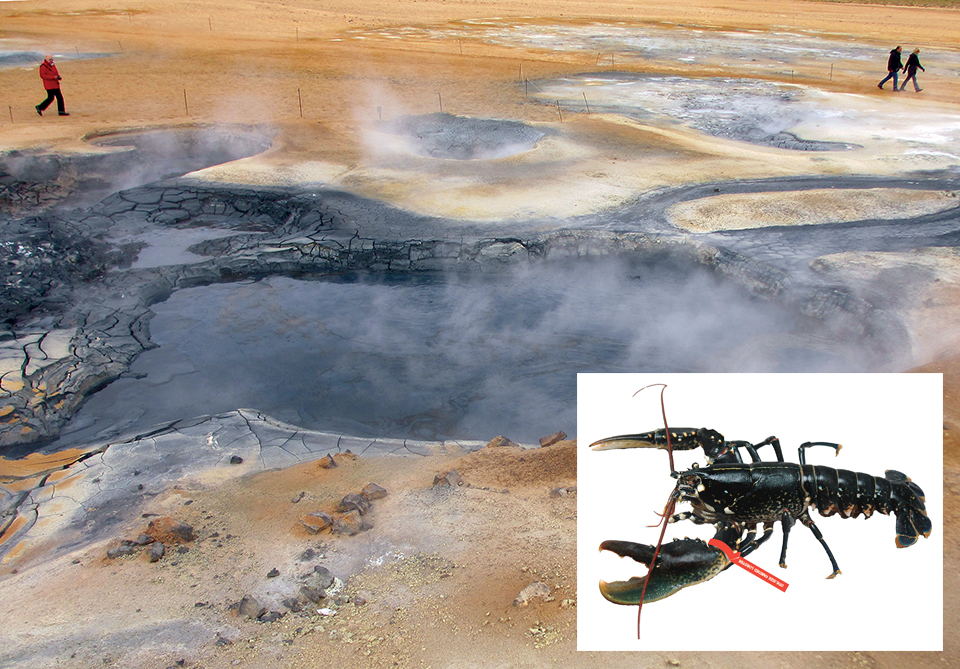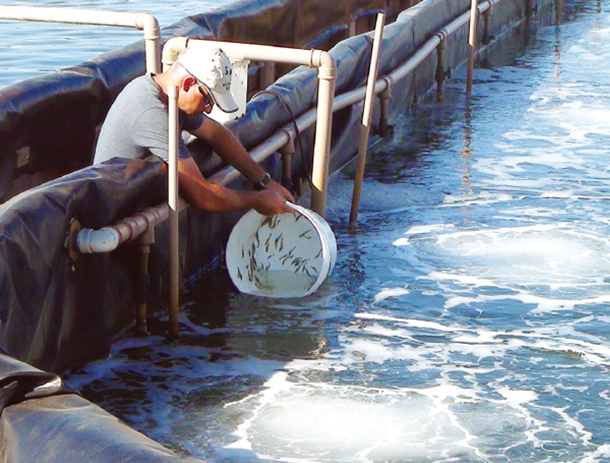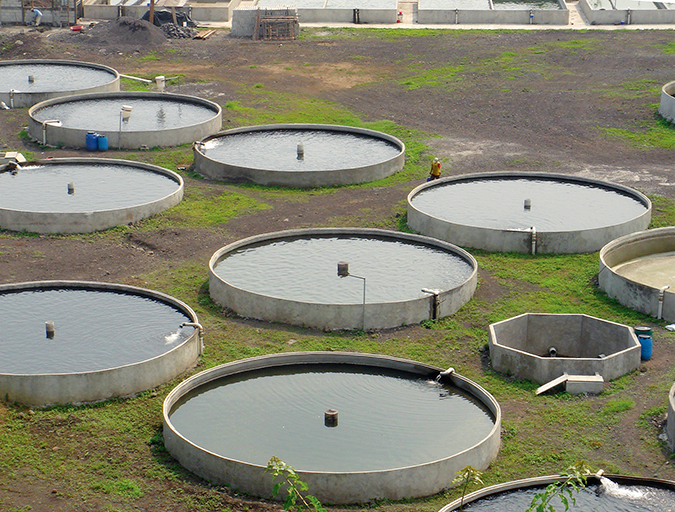Aquifer water, or well water, often has low redox potential and fairly low pH

Water from wells is sometimes used in aquaculture systems. Rainwater that infiltrates the land surface percolates through soil and deeper geological formations until it reaches an impermeable stratum of rock. Water is trapped in voids of the geological formation above the impermeable, confining stratum.
This saturated formation is called an aquifer, and water in it is known as groundwater. The best aquifers for wells are in formations of gravel or sand, but wells also are developed in silt, clay, cavernous limestone and fractured rock.
Groundwater issues
Before reaching an aquifer, water percolates through the root zone, where it can become depleted of dissolved oxygen and charged with carbon dioxide because of respiration of soil organisms – especially in warm weather. Thus, groundwater often has low redox potential because of oxygen depletion and fairly low pH because of high carbon dioxide concentration.
In cool climates and in winter, groundwater has high concentrations of gases because of low temperature, and it may not be altered much in gas composition while passing through the root zone. If water temperature is higher in aquifers than in infiltrating water, groundwater may become supersaturated with air.
Water in aquifers moves in response to gravity and seeps into streams, lakes and oceans, but aquifers are recharged by infiltration. Nevertheless, a molecule of groundwater resides for months and often for years within voids of geological formations comprising aquifers.
Prolonged, contact of water with the geological matrix of an aquifer favors dissolution of minerals, and groundwater often is more concentrated in dissolved substances than is surface water in a particular area. Minerals vary in solubility, and groundwater composition can be highly variable from one aquifer to another.
Varied chemistry
Groundwater from gravel or sand formations – particularly in areas where soils are highly leached and bedrock is insoluble – can be weakly mineralized and acidic (Table 1, sample A). Groundwater from limestone formations, on the other hand, is basic in reaction with appreciable alkalinity and hardness (Table 1, sample B).
In coastal areas, there can be aquifers in which water of marine origin has been displaced over geological time by freshwater. Cation exchange sites in the geological matrix of such an aquifer remain saturated with sodium. If water percolating into the aquifer passes through limestone, the water attains high calcium and bicarbonate concentrations.
Calcium in the aquifer, because it is held more tightly to cation exchange sites, will exchange with sodium in a process called natural softening of groundwater. Water from such aquifers has high alkalinity but low hardness concentration (Table 1, sample C).
Saline groundwater
In many regions, saline groundwater ranging from slightly brackish to more salty than seawater is rather common (Table 1, sample D). Sources of saline groundwater include intrusion of marine water into aquifers in coastal areas, dissolution of salt deposits of marine origin by infiltrating water or water in aquifers, and aquifers containing connate (or fossil) marine water.
Saline groundwater often has different proportions of major ions than found in normal seawater. In particular, it may have lower concentrations of potassium and magnesium than would be expected in water of marine origin with the same salinity.
Other issues
Groundwater low in pH and redox potential dissolves iron and manganese compounds that occur in water-bearing formations. It is not uncommon to find iron concentrations of 20 to 100 mg/L and manganese concentrations up to 20 mg/L in waters from some aquifers. Of course, if appreciable sulfate is present in waters of low redox potential, sulfide resulting from sulfate reduction can precipitate iron as iron sulfide, but the waters may have high sulfide concentration.
Other water quality issues sometimes presented by groundwater are high concentrations of phosphate, nitrate or ammonia nitrogen (although seldom in combination), discoloration by humic substances, and elevated concentrations of one or more trace elements.
In most areas, there is local knowledge about the suitability of surface water for aquatic life, but such information usually is lacking for groundwater. Those interested in using groundwater from wells for aquaculture purposes usually should have the potential source water subjected to a thorough chemical analysis.
Degassing, aeration
Several problems related to groundwater use in hatcheries and holding or transport vessels – gas supersaturation; low dissolved-oxygen concentration; high concentrations of carbon dioxide, ferrous iron, manganous manganese and sulfide; and excess bicarbonate and calcium – can be alleviated by degassing or aeration.
Water can be routed to fall through a series of screens or other porous media to increase the area of contact with air. This degases water or add dissolved oxygen – whichever is necessary. Ferrous iron and manganous manganese are oxidized and precipitate, and removal of carbon dioxide from some waters causes calcium and bicarbonate to precipitate as calcium carbonate. These precipitates can remain suspended in water long enough to harm eggs and larvae, and thus should be removed by sedimentation or sand filtration.
Groundwater for use in ponds usually does not have to be degassed or aerated, because the rate of inflow into ponds is slow enough for the processes described above to occur naturally without harm to the culture species.
Hatchery, pond use
Acidic water for hatcheries may need to be treated with liming material. Also, in ponds with acidic, low-alkalinity water, liming is necessary to provide a good aquaculture environment.
In ponds filled with water of low hardness and high alkalinity, photosynthesis will cause abnormally high pH. This perturbation can be avoided by treating ponds with calcium sulfate or calcium chloride to increase hardness to a concentration approximately equal to alkalinity. The treatment rates can be estimated by multiplying the difference in alkalinity and hardness by 1.72 for calcium sulfate.
Marine shrimp can be cultured in inland areas in ponds filled with low-salinity, 2- to 10-ppt groundwater. Where potassium or magnesium concentration is low, muriate of potash fertilizer or potassium magnesium sulfate can be applied to ponds. It is economically feasible to raise potassium concentration to the level that would occur in seawater diluted to the salinity of the pond water. This concentration can be estimated by multiplying the salinity of the pond water by 10.7. Usually, it is too expensive to increase magnesium concentration by more than 10 or 20 mg/L.
A chelating agent can be added to water from hatcheries to chelate heavy metals and render them nontoxic. Ethylenediaminetetraacetic acid (EDTA) treatment at 5-10 mg/L is often used.
(Editor’s Note: This article was originally published in the January/February 2012 print edition of the Global Aquaculture Advocate.)
Now that you've reached the end of the article ...
… please consider supporting GSA’s mission to advance responsible seafood practices through education, advocacy and third-party assurances. The Advocate aims to document the evolution of responsible seafood practices and share the expansive knowledge of our vast network of contributors.
By becoming a Global Seafood Alliance member, you’re ensuring that all of the pre-competitive work we do through member benefits, resources and events can continue. Individual membership costs just $50 a year.
Not a GSA member? Join us.
Author
-

Claude E. Boyd, Ph.D.
Department of Fisheries and Allied Aquacultures
Auburn University
Auburn, Alabama 36849 USA
Tagged With
Related Posts

Innovation & Investment
Pilot lobster production facility in Iceland used geothermal groundwater
Following earlier work in southwestern Norway that achieved semi-commercial production of European lobsters, a project has received grant support to develop commercialized land-based recirculating aquaculture of lobsters utilizing geothermal water sources in Iceland.

Innovation & Investment
Brazil study results encouraging for injector
Zero-exchange biofloc systems allow elevated stocking densities and production, but also require more dissolved oxygen and thorough water circulation. A new type of air injector uses only a centrifugal pump to recirculate water while naturally aspirating ambient air.

Responsibility
Calcium and magnesium use in aquaculture
Aquatic plants and animals get the essential nutrients calcium and magnesium from water and food. Calcium concentrations impact the hydration and development of eggs in a hatchery, where calcium carbonate precipitation can be troublesome.

Innovation & Investment
Matorka aims to unearth innovation with Arctic charr
A new and ambitious Iceland company is about to construct what it claims will be the world’s largest land-based salmonid farm. What sets Matorka’s Arctic char farm apart is its ability to tap into natural resources unique to the island nation.


